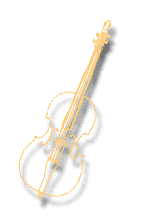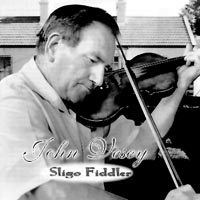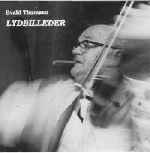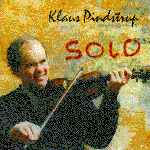
Stacy Phillips looks at the fiddling tradition in
Poland
Irish America
Denmark
Sweden
Iran
Cajun country
Cyprus
Canada
Book Review: Fiddling for Norway
Book Review: Lone Star Swing

|
Fiddle and Bow Stacy Phillips looks at the fiddling tradition in Poland Irish America Denmark Sweden Iran Cajun country Cyprus Canada Book Review: Fiddling for Norway Book Review: Lone Star Swing
|
Fire In The Mountains - Polish Mountain Fiddle Music
The Tatra Mountains of Poland, just north of Slovakia, is home to a native fiddle style and repertoire, so called gorale ("mountaineer") music.
Most of the pieces feature an insistent, almost plodding, downbeat, double stopped rhythm by one or two "seconding" violin and the cello-like basy, with rare references to off beats. All the pieces are for local dance forms and are in 2/4, but with no waltzes, polkas or other dances common in the rest of Poland. A couple of cuts are for listening with semi-rubato vocals.
On the instrumental portions the rhythm is regular, but during vocals it often lurches; slowing down and occasionally lengthening a measure or two, seemingly to conform with the phrasing of the lyrics. The singing is high pitched and a bit constricted - typical of mountain music of other cultures; an unaffected calling (almost yelling) style of vocal.
Each song is pretty much evenly divided into vocal and instrumental portions, though the melodic relation between the two is often tenuous to my ears. The fiddle plays one or two measure-long jagged motives with repetitions. The playing style is a bit reminiscent of other Eastern and Central European styles, but is much less florid than any gypsy style.
Volume One documents the Karol Stoch Band from 1928-29, recorded in America for fellow Polish immigrants. Stoch is the lead violin, and the style leaves plenty of room for variation. Volume Two presents three groups (including Stoch) from the late 1920's, with a selection of cuts from the early 1950's.
The notes in both volumes are authoritative, allowing gorale rookies to follow the proceedings. If you want to start with one CD, I would advise Volume Two for the variety of performers. Be the first on your block to learn what shepherds sing about on those lonely vigils for lost sheep. - Stacy Phillips
John Vesey
Most of the cuts are medleys from the repertoires of the first
great disseminators of the Sligo style like Michael Coleman, with reels
predominating by far along with a couple of jigs and hornpipes.
Vesey has great, strong tone and a no-nonsense approach. There is
some unison playing with several fine flute players and a couple with a
second fiddler. Unfortunately, some of the pieces are accompanied by a
pianist with a strange sense of chord content . (Perhaps this player also
was influenced by the notorious pianist on many Michael Coleman classic
recordings.) A wonderful collection, particlularly for fiddlers. - Stacy Phillips
Sound files are from the album, traditional songs, PD. Used by permission.
Evald Thomsen
The fiddle trios were a highlight for me with excellent double
stopped, rhythm violin and low harmony fiddle accompanying Thomsen's leads.
The twelve strings create a beautifully wheezy ambience. There are also
some guitar-fiddle duets as well as solos.
Thomsen's repertoire includes jigs, reel-like like pieces, galops,
waltzes, and complex solo listening pieces from the Himmerland, Vendsyssel
and Sk�rping areas of Denmark. While the overall approach marks these
pieces as Scandinavian, they are easily distinguishable as something
different from Swedish or Norwegian styles.
The notes are in Danish and relate how he came to learn his
repertoire from older players born to the tradition. After World War II,
he founded a folk musician's society and provided venues for them to play.
There are a couple of cuts where Thomsen intersperses tunes with spoken
reminiscences and thoughts about the elements he feels are basic to this
style of music. He demonstrates the swing and bowing that makes the music
danceable.
The Folkemusikhusringen also carries a book of tunes by Thomsen.
Klaus Pindstrup
Trads represented an old style, being born in 1904. and having
learned from his father and older brothers. He was known as both a player
and teacher.
Eight of 22 cuts are Pindstrup originals and the rest are in Trads'
style, with a bonus of three old recordings played by Trads himself (who
died in 1989). Though less flamboyant than the student, the teacher
displays the same rhythmic and dynamic intensity.
Pindstrup is a virtuosic player employing lots of variation with
bravura passages of double string action, staccato bouncing bows (though
not spicatto), pizzicato, and string crossing motives; all accomplished
with very dynamic and rhythmically driving aplomb. He bows very hard,
probably an effect of the solo style.
His repertoire consists of up tempo waltzes, pulsating waltz-like
"triangles" (a Trads specialty) and mazurkas, two steps, polkas, reel-like
pieces and a galop.
Many thanks to Marianna McKim for translations from the Danish notes
Ghazal (Kayhan Kalhor & Shujaat Husain Khan)
Ghazal is a fine addition to the modern syncretic fund of world
music fusions. Kayhan Kalhor is an Iranian ex-patriot and a virtuoso of
the kamencheh. This is the spike fiddle of much of western Asia. This is
played while seated cross legged on the ground; held and bowed cello
style. It has four strings and is about the length of a violin, though the
body is much smaller, resembling that of an nineteenth century gourd banjo.
He is joined by north Indian sitar player/vocalist Shugaat Husain Khan
plus Indian percussion (mostly tabla)
Persia is one of the major sources of classical Indian music, and
both countries have had considerable Arab influence, so there is much
common ground in basic approach to music. This serves as a bridge for these
masters of their respective classical and folk repertoires.
Much of their playing here is rubato contemplations on modes and
formats that are shared by their respective traditions. These are
solidified by composition of basic phrases, then expanded by their
improvisational skills. Kalhor beautifully mirrors many of the vocal and
sitar lines put down by Khan.
Violinist and fiddlers should find Kalhor's style of great
interest; full of melodic, pitch and rhythmic subtleties.
Three From Sweden
Some folks at a company called Giga Folkmusik (Borsheden, S- 780 40, Mockfjard, Sweden, email: [email protected]) has gotten it their heads to produce a series of unaccompanied, old time Swedish fiddling collections. Each CD focuses on a repertoire and style localized to a particular Swedish community and concentrates on the putatively oldest part of the local repertoire (and some newer pieces written in archaic style).
The albums contain 26 - 32 short pieces consisting of the typical Swedish tune styles: listening melodies, polskas, waltzes, fiddle-ized songs, walking tunes and even a couple of cow herding numbers. The rhythms of the pieces vary from semi-rubato to lurching 3/4 with quirky (at least to non-Scandinavians) dotted rhythms.Of the three that I have heard, there is no doubt that each performer is a veteran master of his realm of tunes, and the clarity of the recordings of lone fiddle makes them a fine learning tool. (Current techniques are sufficiently sensitive to pick up their breathing patterns.)
Bjorn Stabi probably was the first traditional Swedish fiddler to perform in the United States when he appeared in a duet with Ole Hjorth at the Newport Folk Festival about thirty years ago. Their performances, filled with sonorous harmonies and exotic melodies, were a life changing moment for many listeners. Stabi remains one of the most renowned folk fiddlers in Sweden. Bjorn Stabi's Orsalater (GIGA 35) is his first album of tunes from his ancestral home of Orsa. Apparently the project was unrehearsed, recording old tunes as they popped into his memory. There some jarring but tasty non-tempered notes, usually said to speak for the considerable age of a piece.
I will describe two other CD's in the series perfunctorily, not because of any shortcomings - they are equally fine expositions of Swedish fiddle - but because of my limited knowledge of the music.
In Kalle Almlof's Lejsmelatar (GIGA 30) Almlof explores the repertoire of the Lejsme region of Sweden's northwest. "Pers Hans Olsson's Latar Inifran" (GIGA 37) features Olsson's beautiful interpretation of Rattvig district tunes. There seemed to be markedly fewer drones and trills in these than in Stabi's album.
If these CD's are harbinger of more to come in the same vein, then it is a great time to get into Swedish fiddling. And because the notes are bilingual you get a chance to pick up a bit of the lingo.
Dennis McGee
Most of the current crop of popular cajun and zydeco bands feature
the button accordion, with the fiddle, if any, taking a definite supportive
role. However, the squeeze box was not introduced into that part of
America until the turn of the twentieth century.
Echoes of pre-accordion, nineteenth century and earlier cajun music
can be heard on The Complete Early Recordings of Dennis McGee, an
under-recorded but extremely influential fiddler. The notes describe his
music as "the true vine" and the "dictionary" of cajun fiddling. All my
cajun contacts agree. When you listen to this album, covering 1929-`30,
you are experiencing a "deep" version of the Franco-American tradition that
was archaic even at the time of its original recording. This is obviously
a labor of love by its producers, and the rarity and importance of this
music merits the support of all people interested in folk violin. Most
importantly, the music is great; both potent and easily accessible.
All the cuts feature two fiddles and McGee's super-intense vocals.
The second fiddle by either Sady Courville or Ernest Frugé serves a
rhythm/chord function with lots of shuffled, droning double stops.
The accompanying notes are brilliant and include lyrics and
translations. They also contain a helpful discussion of his fiddling
technique. There are 26 songs including "Mon Chère Bébé Créole," "La
Valse Pénitentiaire," "Adieu, Rosa," and "Myself" - over an hour of great
listening.
Cyprus: The Tradition
Cyprus is an island currently split between tense Greek and
Turkish sectors. The music in this album represents a predominantly Greek
influence. For those unfamiliar with this I would compare it a bit with
Roumanian folk music without chordal accompaniment and obvious touches from
the Near East.
Here Andreas Aristidou provides the melodic lead on violin while Kyriacos
Zittis supplies droning rhythmic backings on lauto. (The latter sounds
like a cross between a Turkish oud and a bouzouki.) Zittis also supplies
vocals on about a third of the 21 short pieces.
The violin solos vary from heart-wrenching rubato pieces to
up-tempo, driving dance tunes. As with most folk music that does not have
chordal accompaniment, there are plenty of embellishments, with trills and
occasional, gentle slides. Many of the dances come from a common pool of
melodies known throughout Greece, but done here in Cretan fashion, as
different from other Greek styles as a New England version is from one from
Texas. (For example check Greek-Oriental Songs and Dances on Folklyric
9033 for other versions of several of these tunes with lots of fiddling.)
The excellent notes in French and English supply a enough of
musicological background to aid greatly to the enjoyment and understanding
of the bases of the tunes.
Book Review:
Though not specifically a music book, this travelogue of a Scotsman's
journey through Texas in search of the spirit of Bob Wills should appeal to
all fans of western swing. McLean, a successful writer in his Orkney Island
home is a rabid fan of this music and took advantage of the money from a
literature prize to visit the towns and dance halls he knew only from old
records.
The book details his personal views (often quite hilarious) of the denizens
of the Lone Star State and their haunts. And there are some great fiddle
moments. How about this for a description of Buddy Ray's electrified tone -
"sandpaper spread with honey." And learning that Stuff Smith used to jam
with Ray and Joaquin Murphy (the great steel player) in 1956. And what
really happened when Wills first played the Grand Ol' Opry?
All his descriptions of meetings with the veteran musicians of this style
are charged with insight and fondness. McLean's trek climaxes at the Bob
Wills Days celebration in Turkey, Texas. As with most travelogues, the
writer can get pretty testy after ten thousand miles and a few weeks on the
road, but the moaning and groaning are delivered with a sharp sense of
humor. - Stacy Phillips
See also: North America, Sweden, Ireland, Europe
Stacy Phillips is a Grammy award winning player of fiddle and dobro. He has written over 20 books on about the instruments. He can be reached by e-mail at [email protected]
Volume 1 - The Karol Stoch Band
Volume 2 - The Great Highland Bands
Yazoo (www.shanachie.com)
Sligo Fiddler
private issue (available via Gael Force / www.gaelforce.com) When I showed this two-CD album to the participants at the local
Irish fiddle session, their eyes lit up. Vesey has a great reputation, but
only one 25-year-old commercial recording (on Shanachie) and all were
anxious to hear more of this legendary practitioner of the art. This is a
collection of radio checks and home recordings of this great Irish-American
fiddler spanning 1954 to 1975, so the sound fidelity is sometimes mediocre, but
the playing is uniformly grand.
When I showed this two-CD album to the participants at the local
Irish fiddle session, their eyes lit up. Vesey has a great reputation, but
only one 25-year-old commercial recording (on Shanachie) and all were
anxious to hear more of this legendary practitioner of the art. This is a
collection of radio checks and home recordings of this great Irish-American
fiddler spanning 1954 to 1975, so the sound fidelity is sometimes mediocre, but
the playing is uniformly grand.
![]() Reel: "Dinny O'Brian's" (excerpt), with Ed Lee, piano
Reel: "Dinny O'Brian's" (excerpt), with Ed Lee, piano
![]() Hornpipe: "The Ballyoran" (excerpt) with C. Fahey, flute and Tom Standeven, uillean pipes
Hornpipe: "The Ballyoran" (excerpt) with C. Fahey, flute and Tom Standeven, uillean pipes
Lydbilleder
Folkemusikhusringen (www.folkmusic.dk/fmhr)

![]() There have been tons of Scandinavian fiddling made available
recently in the United States. Sweden, Norway and Finland have been amply
represented but who has ever heard of a Danish fiddling tradition? The
"Lydbilleder" album by the late Evald Thomsen blows the cover off this
under-publicized style and blew me away. The pieces were recorded between
1963-80 with many informal, live cuts at a restaurant and folk music
festival.
Thomsen's playing is more driving than any Scandinavian fiddlers I
have ever heard. The bowing fairly explodes on many cuts. Even the waltzes
are amazingly energetic.
There have been tons of Scandinavian fiddling made available
recently in the United States. Sweden, Norway and Finland have been amply
represented but who has ever heard of a Danish fiddling tradition? The
"Lydbilleder" album by the late Evald Thomsen blows the cover off this
under-publicized style and blew me away. The pieces were recorded between
1963-80 with many informal, live cuts at a restaurant and folk music
festival.
Thomsen's playing is more driving than any Scandinavian fiddlers I
have ever heard. The bowing fairly explodes on many cuts. Even the waltzes
are amazingly energetic.
Solo
Folkemusikhusringen (www.folkmusic.dk/fmhr)
 Solo playing has been all but lost in the Danish tradition,
although it was very common at one time. (It has not been lost to the same
degree in Norway and Sweden.) Klaus Pindstrup's Solo is a tribute to his mentor
Otto Trads. Pindstrup began to play with Trads in the northern part of
Jutland called Himmerland when he was 13. He learned in the traditional
style, without formal lessons, playing along with Trads and other older
fiddlers in Trads' house. He experienced this apprenticeship for about
four years.
Solo playing has been all but lost in the Danish tradition,
although it was very common at one time. (It has not been lost to the same
degree in Norway and Sweden.) Klaus Pindstrup's Solo is a tribute to his mentor
Otto Trads. Pindstrup began to play with Trads in the northern part of
Jutland called Himmerland when he was 13. He learned in the traditional
style, without formal lessons, playing along with Trads and other older
fiddlers in Trads' house. He experienced this apprenticeship for about
four years.
See also: Denmark
As Night Falls On The Silk Road
Shanachie Records (www.shanachie.com)
The Complete Early Recordings Of Dennis McGee
Yazoo 2012 (www.shanachie.com)
with Andreas Aristidou and Kyriacos Zittis
Playasound 65148 (France)
Lone Star Swing
by Duncan McLean
(W. W. Norton & Company)
Some of these reviews appeared first in Strings magazine.